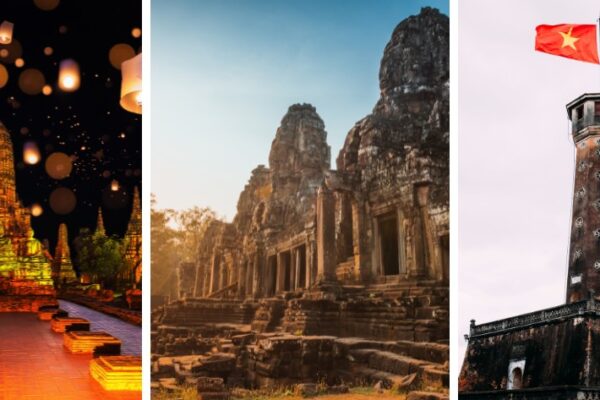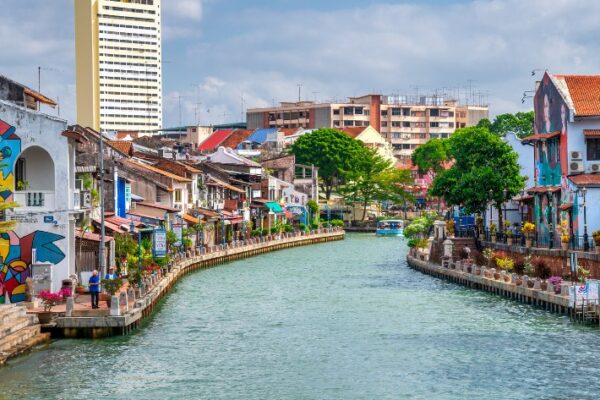Discover Thailand in Rainy Season: A Monsoon Adventure Awaits
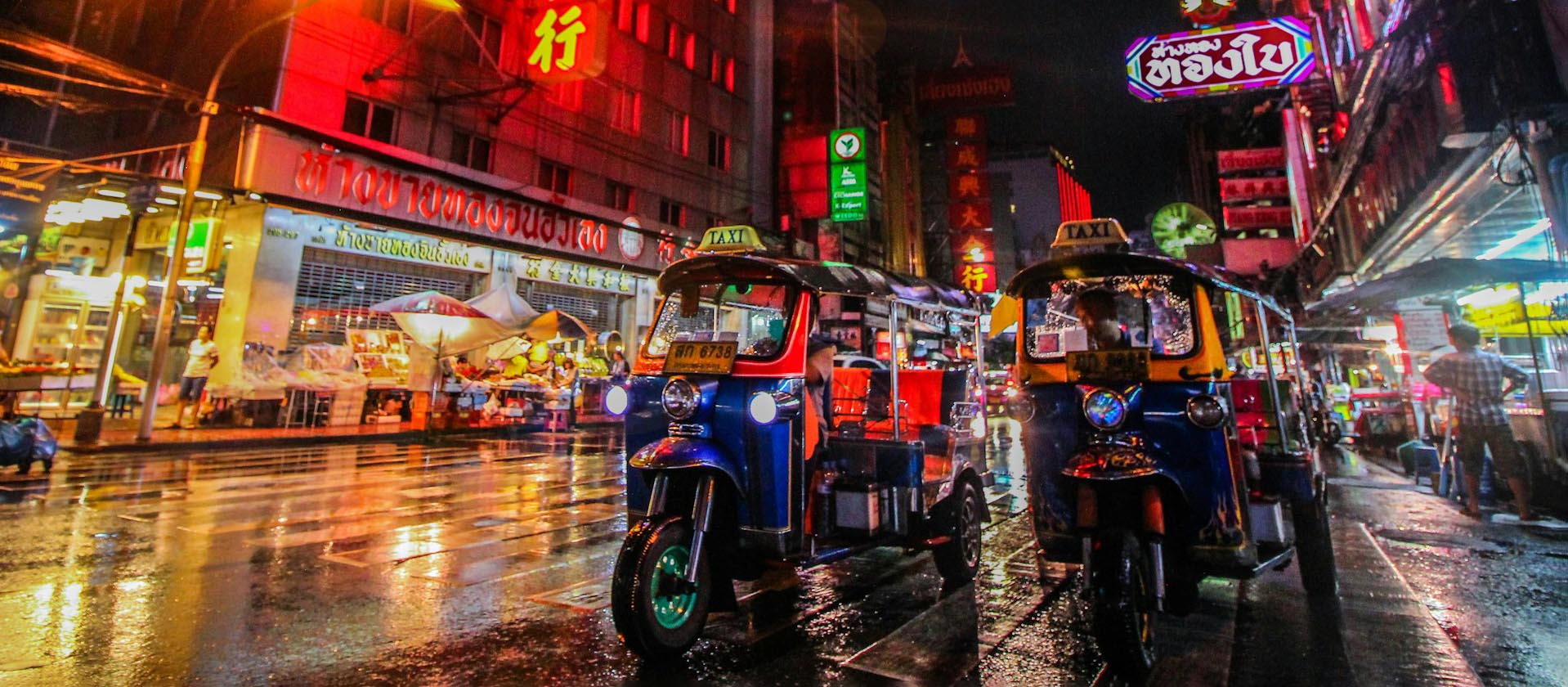
Dive into the vibrant world of Thailand in rainy season, where dramatic skies and emerald rice terraces meet cozy cafés and indoor cultural gems.
Whether you’re chasing waterfalls in the north, island-hopping under clear-skied windows, or indulging in megamall retail therapy in Bangkok, this guide equips you with timing insights, detailed packing lists, savvy transport hacks, monsoon-proof activities, standout destinations, and essential safety tips for an unforgettable rainy-season journey.
Understanding Thailand in Rainy Season
When Is It
Thailand’s rainy season generally spans from June to October, with the heaviest rainfall typically occurring in August and September. This period is influenced by the southwest monsoon, which brings increased humidity and frequent rain showers across the country.
In Bangkok, for instance, the rainy season typically begins around late June and lasts until early October, with intense afternoon and evening downpours common during July and August.
For travelers, it’s noteworthy that mornings are often clear and dry, especially between 05:00 and 10:00, making it an ideal time for outdoor activities and sightseeing. Rainfall typically occurs in the late afternoon and early evening, providing a natural respite from the day’s heat and an opportunity to explore indoor attractions or savor local cuisine.
What’s the Rain Like
Rain in Thailand in this season varies dramatically by region:
- Tropical Downpours: Sudden, intense showers—sometimes accompanied by lightning displays—drench landscapes in minutes, making them ideal for dramatic photos.
- Lingering Drizzles: Gentle, continuous rain along the Andaman Coast extends for hours, creating romantic, mist-filled beaches.
- Intermittent Showers: Chiang Mai’s hills often see on-and-off drizzles, with sunbreaks that paint the valleys gold.
And the average monthly rainfall varies significantly by place:
- In Bangkok, the wettest month—typically September—sees an average of approximately 334 mm of rainfall.
- Chiang Mai experiences its peak rainfall in August, averaging around 217 mm.
- Meanwhile, Krabi, located on the Andaman coast, receives up to 355 mm of rain in September.
While these figures may seem daunting, they also signify the monsoon’s enriching effects—lush green landscapes, powerful and pristine waterfalls, and quieter beaches that offer a more tranquil experience for adventurous travellers.
Regional Variations
- Andaman Coast (Phuket, Krabi, Phi Phi): July–September sees rough seas and cancelled ferries, but morning snorkelling trips can still be clear.
- Gulf Coast (Koh Samui, Koh Phangan, Koh Tao): July–August are unexpectedly drier months, making Koh Samui a prime Thailand in rainy season alternative to the Andaman side.
- Northern Highlands (Chiang Mai, Chiang Rai): Mist-shrouded mornings and roaring waterfall treks from June through August—ideal for eco-tourism and jungle stays.
- Central Plains (Bangkok, Ayutthaya): Rapid flash floods test drainage systems; yet covered skywalks and elevated walkways keep you dry exploring markets and temples.
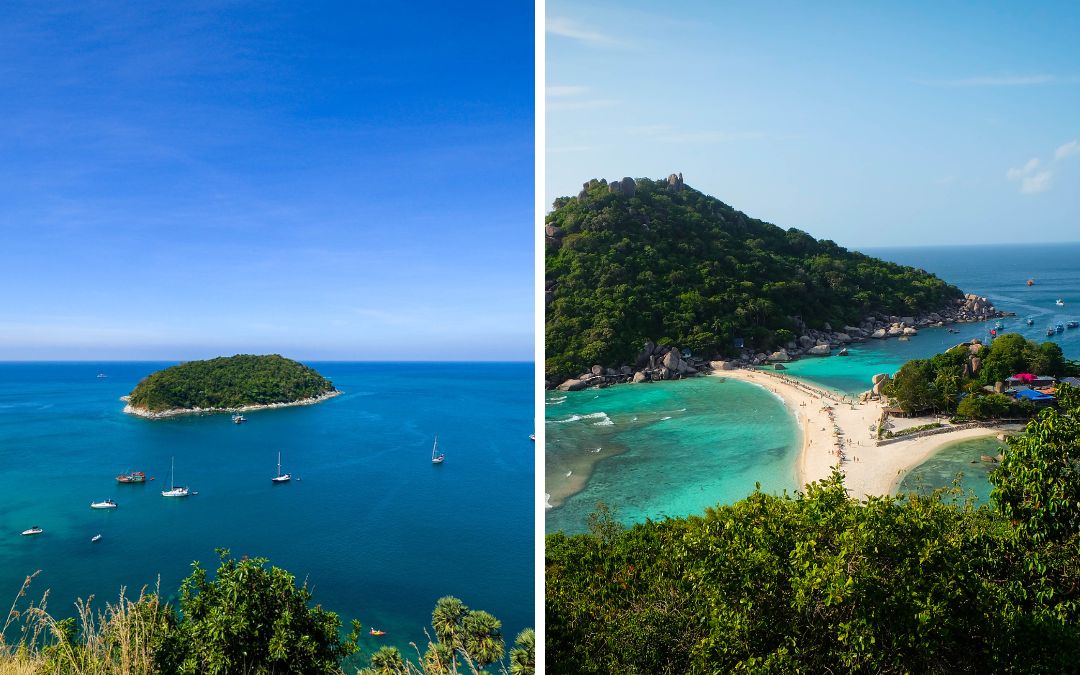
The Andaman Coast and the Gulf Coast of Thailand experience different patterns of rainfall
Understanding these nuances helps you plan your ideal rainy season itinerary—whether you want to surf incoming swells, photograph emerald paddies, or sip coffee as rain drums on tin roofs.
>> Read More: How To Choose The Best Time To Visit Thailand Based On Your Travel Style
What to Pack for Rainy Season Travel
Essentials
- Quick-Dry Clothing: Moisture-wicking T-shirts, sarongs that double as wraps, and travel underwear with antimicrobial finish ensure comfort through multiple wears between washes.
- Waterproof Outerwear: A lightweight, packable rain jacket with underarm vents and a foldaway hood beats bulky ponchos—and keeps your bag contents dry.
- Water-Resistant Footwear: Closed-toe sandals with neoprene linings and grippy soles protect toes and prevent slips on slick boardwalks.
Tech Tips
- Waterproof Phone Case & Dry Bag: Look for IPX8-rated cases and floating dry pouches—vital on boat trips to the Similan Islands or coastal tuk-tuk rides.
- Ziplock & Silicone Pouches: Label each bag with a sharpie: “Cash,” “Cards,” “SIM”—so you can retrieve essentials quickly in sudden downpours.
- Portable Power Bank & Solar Charger: Rain can trigger power cuts in rural provinces; a solar panel strapped to your daypack keeps you going off-grid.
Extra Travel Gear
- Microfiber Towel & Sarong: Dual-purpose sarongs can be beach blankets by day and lightweight rain shields by night.
- Umbrella with Vent Holes: A Japanese-style vented umbrella resists flipping inside out during gusty monsoon winds.
- Mini First-Aid Kit: Waterproof plasters, antiseptic cream, and non-latex gloves come in handy for minor cuts from barnacle-crusted rocks or slick forest paths.
- Insect Protection: Pack DEET repellent (30%+), permethrin-treated clothing, and a pop-up mosquito net for open-air bungalows.
Sustainable Packing
- Biodegradable Poncho & Recycled Gear: Brands using recycled PET or biodegradable TPU help reduce single-use plastic waste in tourist hotspots.
- Solid Toiletry Bars: Ditch shampoo bottles for Lush-style bars in compostable packaging—drys faster on a sink ledge.
>> Read More: How To Plan A Trip To Thailand – A 7-Step Guide For First-Timers
Transportation Tips
Getting Around During Rainy Days
- Ride-Hailing Apps (Grab, Bolt): Trust the GPS tracking and fare estimates. Tip drivers 10% when navigating flooded streets—they’ll appreciate the gratitude.
- Tuk-Tuks & Metered Taxis: Always confirm meter operation or negotiate a cap. During monsoon surges, expect drivers to add a “rain surcharge” of $0.3–0.6.
- Songthaews & Local Buses: Cheaper but often uncovered—sit toward the back under the canopy and cover your pack in plastic.
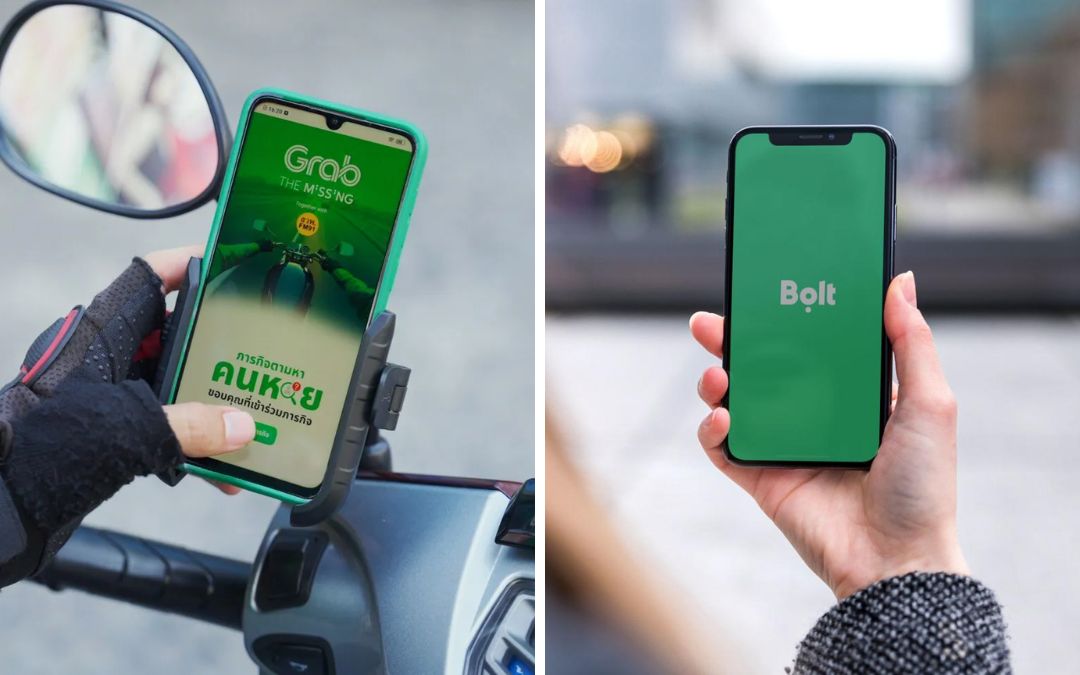
Grab and Bolt are both popular in Thailand
Island Hopping Advice
- Morning Ferries Only: Book departures before 10:00. Most cancellations occur in the late afternoon when seas swell.
- Motion-Sickness Remedies: Acupressure wristbands, ginger chews, or prescription Scopolamine patches can prevent queasiness in choppy Gulf waters.
- Charter Boats & Private Transfers: Though pricier, you control departure windows—ask captains to avoid known weather-blown channels.
Rail & Long-Distance Buses
- Overnight Trains: Sleep through the storm on air-conditioned berths from Bangkok to Chiang Mai or Surat Thani—book the upper bunk for a view of lightning-illuminated sky.
- VIP Buses: Reclining seats, blankets, and plug sockets make a monsoon-season bus safer than standing at a flooded pier.
Motorcycle Tours (Moderate Use)
- Guided Wet-Weather Rides: Local guides know which backroads drain quickly. Combine scenic trails like Samoeng Loop with covered stops.
- Safety Gear Upgrade: Full-face helmets, rainproof liners, and reflective bands help keep you visible and dry.
Things to Do in Thailand in Rainy Season
Indoor Attractions
- Bangkok’s Grand Palace & Wat Pho: Covered colonnades let you admire murals and reclining Buddha statues without soggy sandals.
- Chiang Mai’s Artisan Villages: Umbrella-painting classes in Bo Sang and silk-weaving in Bor Sang stay dry in covered studios.
- Museum Trails: Museum of Contemporary Art, Bangkok Art & Culture Centre, and Jim Thompson House offer multi-floor exhibitions of contemporary Thai art—each gallery a monsoon haven.

Bangkok Art & Culture Centre
>> Read More: Bangkok Travel Guide – Your Essential Companion to the Heart of Thailand
Cafés & Local Hangouts
- Riverside Cafés: Bangkok’s decked-out coffee shops along Saen Saeb Canal offer refuge and people-watching as rain falls on colourful boats.
- Specialty Coffee Roasters: Seek out local roasters like Ristr8to in Chiang Mai or Roots in Bangkok’s Charoenkrung district for artisanal brews.
- Covered Night Markets: Talad Rot Fai Ratchada and Chiang Mai Gate market boast expansive covered zones—sample coconut pancakes and grilled skewers without the drizzle.
Cultural Experiences
- Monsoon Festivals: Marvel at floating candle-lit displays in rain-shielded pavilions during the Ubon Ratchathani Candle Festival (July). Or join masked parades under makeshift bamboo canopies in the Phi Ta Khon (June/July).
- Thai Cooking Masterclasses: Learn to balance sweet, sour, salty, and spicy—most schools operate under retractable roofs to keep rain at bay.
- Temple Meditation & Retreats: In the Wat Suan Mokkh’s Silent Retreat, there are five days of guided Vipassana meditation in retreat halls overlooking misty gardens. Or you can join the early-morning chants echo off wet temple walls in UNESCO-listed ruins of Wat Mahathat, Sukhothai.
>> Read More: Unlock Spiritual Thailand Temple Tours With The Best Stunning Places Of Worship
Nightlife & Entertainment
- Live Music & Speakeasies: Rainy nights in Ekkamai host jazz, blues, and indie acts in basement joints and speakeasy bars.
- Covered Muay Thai Stadiums: Lumpinee and Rajadamnern rings stay dry under grandstand roofing—cheer local champions and train in dry gyms.
>> See Tour: Best of Thailand
Destinations That Shine in Thailand in Rainy Season
Chiang Mai & Northern Highlands — Scenic, Less Crowded, and Green
Travelers can expect:
- Emerald Rice Terraces: Ban Pa Pong Piang and Mae Klang fields brim with seedlings; staying with a hill-tribe family offers authentic planting experiences.
- Spectacular Waterfalls: Mae Sa, Bua Thong (Sticky Waterfall), and Mok Fa explode with flow—join guided canyoning tours for safe, adrenaline-filled dips.
- Hill-Tribe Homestays: Akha and Karen villages provide bamboo-thatched huts with tin roofs—wake to mist-clad valleys and villagers offering hot teas.
Koh Samui & Koh Phangan (Gulf of Thailand) — Drier Months During July–August
You might enjoy:
- Beach & Water Sports: Chaweng and Lamai beaches enjoy sunnier spells; snorkeling at Koh Taen and Koh Mudsum can be spectacular.
- Wellness & Retreats: Fusion Maia and Kamalaya offer monsoon-special spa treatments using herbal compresses and rainwater infusions.
- Off-Peak Festivals: Experience Loy Krathong floating lantern ceremonies on Ko Pha Ngan with fewer crowds than in the Andaman.
Bangkok — Urban Exploration, Shopping Malls, Culture
Do not forget to explore the capital with:
- Mega-Malls & Indoor Parks: ICONSIAM’s riverside park, Siam Paragon’s Sea Life Aquarium, and Mega Bangna’s indoor skatepark offer endless dry-weather diversions.
- Riverside & Canal Cruises: Covered long-tail and luxury boats navigate Chao Phraya and khlongs—time cruise dinners with pre-storm sunsets for cinematic views.
- Hidden Rooftop Bars: Find speakeasy-style bars like Sky Bar at Lebua or Above Eleven, where rain-kissed skylines glow beneath umbrellas.
>> Read More: 15 Best Things To Do In Bangkok With Kids
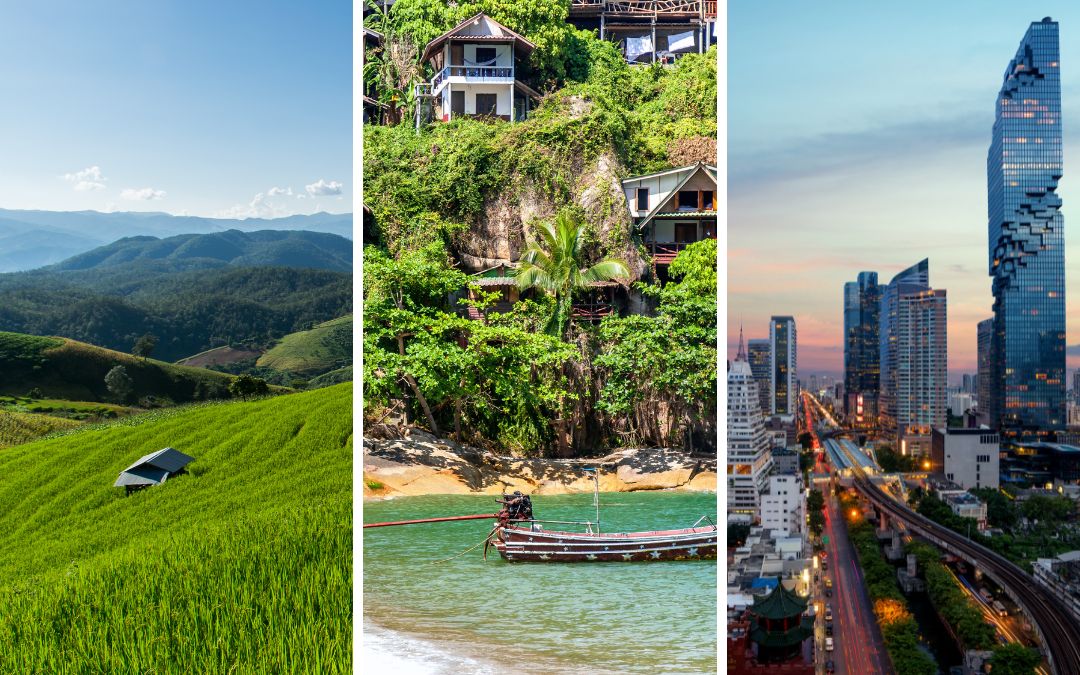
Three destinations that are worth visiting during the rainy season in Thailand
Safety Tips To Travel Thailand in Rainy Season
Flood Awareness
- Real-Time Alerts: Install ThaiWeather, FloodSafe, and use LINE channels for local warnings.
- Avoid Fast-Moving Water: Six inches of flowing water can topple a person; two feet can stall cars—take higher-ground detours.
- Emergency Kit: Keep a “go-bag” with waterproof torch, spare cash, emergency contacts (1155 Tourist Police), and a local SIM card.
Mosquito Protection
- Repellent Ritual: Apply repellent at dawn, dusk, and before bed—mosquito activity peaks in early evening when rain subsides.
- Clothing Layers: Light long-sleeved shirts and pants treated with permethrin add protection without overheating.
- Net & Screens: Ensure your bungalow or hostel dorm has window screens or bed nets—ask ahead or pack a pop-up net for open-air lodgings.
Slippery Surfaces & Roads
- Footwear Selection: Shoes with lugged soles, quick-dry uppers, and adjustable straps prevent sliding on wet leaves and moss-covered stones.
- Safe Driving: If renting a car, insist on tire treads above 4 mm, ABS brakes, and consider an SUV with ground clearance for flooded rural roads.
- Motorbike Etiquette: Avoid sudden braking and accelerations; reduce lean angles on corners; always wear a reflective raincoat to enhance visibility.
Final thoughts
From mist-covered highlands and roaring waterfalls to cozy cafés, bustling indoor markets, and the drier Gulf islands, Thailand during the rainy season reveals a side of the Land of Smiles that is both dramatic and rewarding.
Equipped with smart packing strategies, flexible transportation options, monsoon-proof itineraries, and careful safety measures, you can turn every downpour into an opportunity.
Do not hesitate to craft your Thailand exploration with Asia Pioneer Travel and let Thailand’s monsoon magic enchant you!
